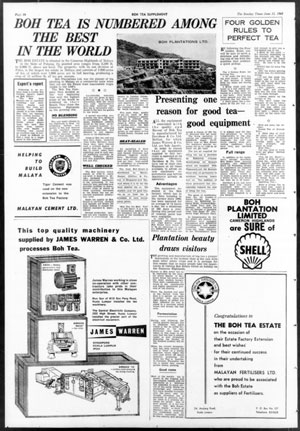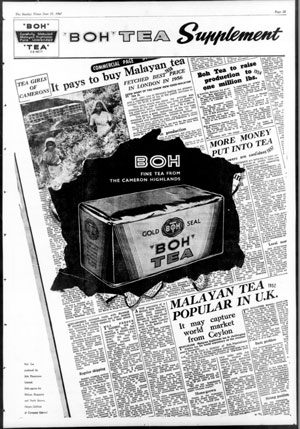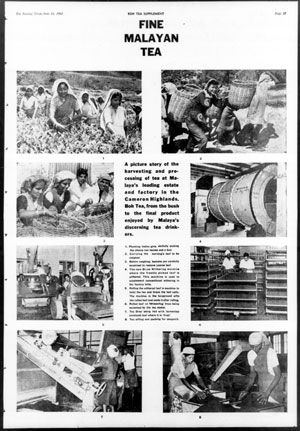
For the descendents of Richard Dearie and his son John Russell

Boh Tea Supplement, Straits Times Sunday June 11 , 1961


BOH TEA SUPPLEMENT
1956 It pays to buy Malayan tea (Fragment) FETCHED BEST PRICE IN LONDON IN 1956 HOW MANY OF YOU KNOW HOW GOOD MALAYAN TEA IS Last year, one of Malaya’s leading tea growers sold a consignment of tea at the public auctions in London for $3.22 a pound! This price which was above the average was obtained at the sale in which teas from all producing countries were auctioned and represents a probable retail price equivalent to over $5 a pound. This gives a good indication of the very high standard of tea production maintained by well organized and progressive tea estates in Malaya. Tea has been grown for many years in Malaya, where the climate particularly in the Cameron Highlands, is ideally suited for the production of it. It is considered that had it not been for the successful development of the rubber industry, tea might have been grown on a l………. …………in production ………….area in production last year was only……..understood that plans to increase the…….in hand and active……extensions in the…..
1954 Boh Tea to raise production to one million LEADING Malayan tea growers, Boh plantations in the Cameron Highlands are to step up production to full capacity of 1,000,000 lb. a year. This was prompted among other things by increased demand for tea in Britain said Mr. J. Drysdale chairman of Boh plantations. Mr. Drysdale said that Malayan tea was much sought after by tea blenders in Britain. Boh plantations famous for its Boh, Tiger 9 and Cameronean brands had a record crop of 800,000 lb. this year compared with 750,000 lb. in 1953. Mr. Drysdale said “the estate is expanding its output by gradual stages and we are planning to increase the yield to a million lb. a year which is the full capacity of our factory. “Our main market is Malaya and only the surplus is exported to Britain.” The company has exported 22 per cent of its produce to Britain during the past two years. Mr. Drysdale said that the British market for Malayan tea had gone up considerably because of the fall in production in Assam and Ceylon caused by unusual weather recently. The price of tea today is about 71d. a lb. compared with 43d. last year.
1957 MORE MONEY PUT INTO TEA (FRAGMENT) Growers are confident TEA GROWERS are believed to have re-…….portion of profits from the….in expanding their plantations. Growers’ representatives in Kuala Lumpur agree that if the high prices for tea continue abroad, Malayan plantations should be able to step up their rehabilitation and expansion programmes. Because of the higher cost of tea production in this country compared with costs in other tea growing countries, it is necessary for Malayan producers to maintain a high standard of quality and to increase their production. The recent high prices enable producers to meet the need. The high prices give them confidence in the future. Growers have further strengthened their position by increasing local sales which were once hindered by cheap imported tea. Most of the high grade…producers have a policy of…..entering the local market and to this end they reserve for sale in Malaya their highest grade of tea and price it competititively with high grade foreign tea. The bulk of lower grade tea has been exported for…..er prices but even low-grade tea producers have not…..ed…..the possibilities of….market. Local market One of the largest….tea producers reports that their local sales have….so much that, whe……ber and January…..conditions were leg….they were unable…..local demand. The highest price…..an tea was obtained….auctions in January..when Highland….4d. a pound an……6s 9 ½ d.
BOH TEA IS NUMBERED AMONG THE BEST IN THE WORLD THE BOH ESTATE is situated in the Cameron Highlands of Malaya in the State of Pahang. Its planted area ranges from 3,500 ft. to 6000 ft. above sea level. The property, with its out division at Palas, is the largest tea estate in Malaya, and consists of 1,900 acres of tea, of which over 1,800 acres are in full bearing, producing a crop of 1 ¾ million lb. of tea per annum. Boh Plantations Ltd. was the pioneer of tea planting in Malaya on a commercial scale when they cut out the Estate from inaccessible virgin jungle in the 1930’s. The Boh Tea Company then decided at the very beginning that only the highest grade of tea would be produced on their Estate. They chose the Cameron Highlands as the growing site. NO BLENDING The cool moist climate in the Highlands is ideal for producing flavour and quality in tea, and because of the constant climate conditions, there is no variation in seasonal quality – a fact that enables Boh to maintain their set standards without blending. Considerable attention and care are given to each individual bush on the Boh Plantation, with the result that such improvements have been achieved that Boh tea is favourably compared to the best tea grades in the world. A special manuring programme has been designed in consultation with Malayan Fertilisers Limited, based on the most up-to-date research institute information from principal producing countries, and adapted to suit requirements of the Highlands. Original Boh tea seed was first class strain, imported from India. Harvests, since those days, have reached such a uniform degree of quality that the Company has, in recent years been exporting seed to such major producing countries as Ceylon, Pakistan, Africa, and also Argentine, Mauritius and Fiji. WELL CHECKED The Boh factory, which stands at 4,700 feet above sea level, is modern in design, equipped with the most advanced machinery in tea processing. It has recently been extended and provides facilities to manufacture crops in excess of those currently harvested as the Estate has not yet reached maximum production level. Made tea quality at Boh Estate is carefully checked and samples are drawn for daily testing to ensure the highest standard is maintained. Normal production samples are also regularly submitted to professional tea tasters in London Colombo and Calcutta, from whom consistently favourable reports have come to give a true indication of the Company’s high value by world standards. Five pure, clean grades of tea are made by Boh and the Company’s packet produce is selected from the best of these. The balance is either auctioned in London where the Boh mark regularly commands the best Malayan tea prices, or sold direct to the United States, Canada and Australia. HEAT-SEALED All packeting is done right on the Estate to ensure factory freshness and strictest hygienic conditions. Handmade packets pass most careful scrutiny and are then heat-sealed in cellophane to guarantee continued freshness. Tea from Boh Estate is distributed by Messrs. Harper, Gilfillan and Co., Ltd., in Singapore and Malaya where it is by far the most popular tea on the market – and for good reason, is no finer tea is available at such economic prices. "Boh Tea the Best Tea" is no idle boast; it is a tea of outstanding quality and the company can be justly proud of the excellence of its product. Expert’s report Following is an extract from a Ceylon Tea Visiting Agents report on Boh Estate: “The Boh Seed Bearers are in excellent condition and show robust health and growth. The trees are sustainably (and widely) spaced. It is very evident that they are vigorous high yielding bearers. I saw an excellent nursery of about 60,000 finally grown plants from this seed. The plants were entirely alike with hardly a variation and carried an excellent type of leaf. It would be difficult to find a fault in a single plant in this nursery”.
Presenting one reason for good tea – good equipment All the equipment associated with the quality and flavour of Boh Tea is manufactured by Davidson and Co. Ltd. Belfast, for which James Warren and Co. Ltd, are Sole Agents. In order to ensure that all equipment supplied to this territory is operated at its optimum efficiency, Davidson and Co. Ltd. have one of their own Engineers at all times available to advise on new machinery requirements and service machinery already in operation. Advantages The equipment installed in the Boh factory, which has in part being installed in the factory since 1949, has been operated for an average of 14 hours a day, for a minimum of 340 days a year. During this period cost of renewal parts has been negligible. In order to obtain the maximum percentage of the high quality grades Boh Estate have found it to be an advantage to use the SIROCCO 46.6 and 47” Rollers, each of which can accept a charge of 900 lbs, of withered leaf per hour. The firing operation is carried out completely in SIROCCO Super E.C. P. Driers and on Boh Estate the machines provide capacity for up to 1,200 lb. of made tea per hour. The hot air are required for firing the tea is provided by SIROCCO Cellular Multi- tubular Air Heaters which are equipped with Wallsend L.A.P. Oil Burners fitted with oil preheaters to facilitate burning heavy fuel oil. The addition of these preheaters has considerably reduced the cost of firing the teas. The gases of combustion from the air heaters is drawn through the machines by SIROCCO Induced Draft, Forward Bladed Cased Fans and the primary air required for the oil burners is provided from Two Stage 20” Diameter High Pressure Fans. As temperatures in the tea driers on are critical the machines are equipped throughout with SIROCCO Thermometers and double recording Thermograms. From the large diameter of the Thermometer Dials is it is always easy for factory personnel to check temperatures in the machines and from the Thermographs the staff can check exactly what prevailing conditions have been over any specified period. Full range In addition to the equipment already described, Boh Estate have recently installed two SIROCCO Mark III Withering Drums to supplement the capacity for withering in the tea factory lofts. These machines effect a wither in 3 ½ hours, equally as good as a wither as in the lofts which can take up to 18 hours. Davidson and Co.Ltd. have always been very closely associated with the tea industry and provide equipment covering the complete range required in a tea factory.
FINE MALAYAN TEA
A picture story of the harvesting and processing of tea at Malaya’s leading estate and factory in the Cameron Highlands, Boh Tea, from the bush to the final product enjoyed by Malaya’s discerning tea drinkers.
1. Plucking: Indian girls skillfully picking the choice two leaves and bud. 2. Carrying the morning’s leaf to be weighed. 3. Before weighing, baskets are carefully examined to remove coarse leaf. 4. The new Drum Withering machine where the freshly picked leaf is withered. This machine is used to supplement conventional withering in the factory lofts. 5. Rolling the withered leaf in machine to twist the tea and break the leaf cells. The machine in the foreground sifts the rolled leaf and cools it after rolling. 6. Rolled leaf on fermenting trays being examined by the tea maker. 7. Tea Drier being fed with fermented (oxidised) leaf where it is “fired”. 8. Tea sifting and packing for dispatch.
Advertisements
HELPING TO BUILD MALAYA MALAYAN CEMENT LIMITED Tiger Cement was used on the new extension to the Boh Tree Factory MALAYAN CEMENT LTD.
This top quality machinery supplied by JAMES WARREN & Co. Ltd. Processes Boh Tea. ASEA-Motors, generators and distribution board. SIROCCO “Senior”—tea roller. SIROCCO ‘75’-endless chain pressure tea drying machine. James Warren working in close co-operation with other contractors take pride in their contribution to this Malayan Enterprise. Mun San of 613 San Peng Road, Kuala Lumpur installed the tea machinery. The Central Electricity Company, 202, High Street, Kuala Lumpur installed the greater part of the electrical equipment. JAMES WARREN SINGAPORE KUALA LUMPUR IPOH
BOH PLANTATION LIMITED, CAMERON HIGHLANDS, ARE SURE OF SHELL.
MALAYAN FERTILISERS LTD, KUALA LUMPUR. STAR BRAND Congratulations to THE BOH TEA ESTATE on the occasion of their Estate Factory Extension and best wishes for their continued success in their undertaking from MALAYAN FERTILISERS LTD who are proud to be associated with the Boh Estate.